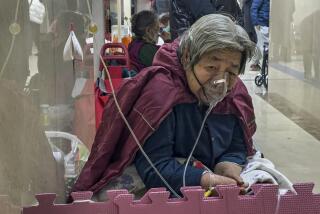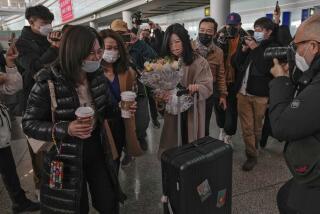China’s coronavirus conundrum: Stay home, don’t get sick, get back to work!
- Share via
BEIJING — It wasn’t that Cai didn’t want to go back to work. The small factory owner had been anxious to get his 40 or so employees back to business, making electronic wires for sound systems, phone chargers and earphones.
But the list of required documents to reopen his factory in Shenzhen in southeastern China was staggering: application for return to work, temperature records for every employee, protective equipment supply and distribution charts, records of workers’ travel, factory disinfection and inspection chart, case files on every employee’s disease prevention training.
That was just the beginning.
China’s battle against COVID-19, the coronavirus epidemic that has infected more than 77,000 people and killed at least 2,360 worldwide, has ground the nation to a halt.
While the rate of increase of new infections appears to be slowing, China now faces a conundrum: bring people back to work, and risk a second spike in infections — or keep them at home, and watch businesses crash.
“We didn’t apply to go back to work. Our application wouldn’t have passed anyway,” Cai, who did not give his full name, said in an interview with local media on Sunday.
Paperwork aside, if any of his workers came from outside the city, they’d have to go into 14 days of quarantine before returning to work. That’s assuming they made it out of their hometowns and villages, many of which are still shut down.
Most factory workers live in cramped dormitories or shared rentals that make self-quarantine impossible. The costs are prohibitive for their employers, too: one factory owner told Chinese magazine Caijing that he paid more than $42,700 to house his returning workers in a local hotel for two weeks.
Cai, like many other factory owners, decided to wait. If restrictions loosened soon, he’d be able to get back into production and make up for the losses.
But he had only enough cash on hand to survive for two months at most, he said — and one month has already passed.
More than 760 million people in China are in some form of home lockdown, spurred by authorities who have ramped up “wartime” rhetoric, sealing off residential buildings, blocking highways and installing body temperature checkpoints everywhere from supermarkets to public toilets. They have implemented permit systems in apartment buildings across the country, where families get limited numbers of passes to leave their homes perhaps every other day, or once a week, or only for two hours at a time, or not at all.
Squads of thermometer-wielding workers guard each neighborhood, ready to test and reprimand anyone who goes out without a protective mask or dares to attempt a group gathering.
“Don’t go out, don’t meet others!” they shout, echoing red banners hung all around.
But China needs to go back to work. Economic growth already slowed drastically last year, with rising food costs, slowed consumption and added pressure from the U.S.-China trade war.
In a survey of manufacturing companies in the Yangtze River Delta released by the American Chamber of Commerce in Shanghai this week, almost 80% of companies said they didn’t have enough staff for full production lines. Nearly 40% said they lacked sufficient protective medical gear for their staff.
So far, the majority of COVID-19 cases have been concentrated in Hubei province, where lack of early response allowed for large gatherings of people in markets, malls, restaurants and workplaces — all of which became infection clusters that have now overwhelmed the health system.
Chinese scientist and government advisor Zhong Nanshan predicted last week that the outbreak would peak in late February and end by April. But scientists outside China say the timing of a peak depends on the effectiveness of China’s quarantines.
A second Hubei would devastate China, especially with the entire nation’s medical resources already diverted to the city of Wuhan, Hubei’s capital, where they have yet to bring the outbreak under control.
But a prolonged shutdown would also be devastating to many of China’s private businesses.
In a survey of 995 small and medium-size enterprises conducted by Tsinghua and Peking universities this month, 34% of companies said they could only survive for one month under the current conditions, 33.1% said they could survive two months, and 17.9% said they’d survive three months at most.
That survey has since been blocked online.
In Beijing, businesses were allowed and encouraged to go back to work on Feb. 10 — but were also ordered to prevent and control the disease at all costs.
Some workplaces restarted too early. One government employee in the capital’s Xicheng district went to work on Feb. 1. He’d visited family in Hebei province in northern China during the New Year holiday, but had no fever or other symptoms. Ten days later, one of his Hebei relatives was diagnosed with COVID-19. The Xicheng worker went to the hospital and found he had the virus as well. All 69 of his colleagues who were also at work that day are now in quarantine.
Most companies have resorted to having employees work from home, though that’s not possible for industries like manufacturing.
On Wednesday in Yizhuang, a tech development zone in Beijing’s southern suburbs, winter sun bounced off clumps of melting snow on sprawling, silent roads. The factory buildings looked desolate, with doors shut, gates locked and windows seeming to sink into the gray stillness behind them.
A guard at the entrance to Futaijing Precision Electronics, a Foxconn subsidiary, said only 200 to 300 of the factory’s 1,000 workers were back at work. Many of the migrant workers who come from other provinces had not yet returned, he said, and those who had were currently in quarantine.
Hayes Lou, who owns a bike helmet factory and is head of the Taiwanese Businessmen’s Assn. in the southern manufacturing city Dongguan, said this outbreak’s impact is worse than SARS in 2003 because Chinese supply chains have become so interlinked, especially in tech manufacturing.
Every factory depends on dozens of other factories to produce its product, he said — the wiring, the chips and parts of the chips, the switches, the packaging — and if any part shuts down, the entire chain breaks.
“It’s impossible that you have a complete supply chain within your factory,” Lou said. A cellphone maker might have several thousand suppliers making the various part of a phone, with production and assembly happening at different factories in different provinces, for example.
“If even just one-tenth of those suppliers don’t get their goods, no matter why, they will definitely be unable to bring out the final product,” Lou said. “They will be out of stock, out of stock, out of stock.”
Authorities have tried to ease business pressures by offering waivers on employers’ pension payments and loan extensions in certain sectors.
Some have tried to bring rural workers back to cities by arranging chartered train trips moving on a staggered schedule, with passengers separated from one another on board.
Mark Williams, chief Asia economist for Capital Economics, said China is nearing a “crunch point” that depends on whether people start to lose their jobs from the outbreak.
As long as people are still getting paid, even if they’re at home, they will eventually come out and spend that money after the outbreak, he said, as they did after SARS. That would make COVID-19 only a “temporary blip” on China’s record.
But if companies are strained, wages drop and unemployment rises, recovery will be much harder, he said, and those problems will start in small companies first.
Feng, the manager of a shipping logistics company in Dongguan, said in a phone interview that he’d left his apartment only twice in the last three weeks. Restrictions were tight, no one was working in his industry, and worse — he was from Xiantao, a city near Wuhan in Hubei province.
Feng, who also declined to give his full name — authorities are telling people not to speak negatively about the outbreak and its impact — hasn’t been to Hubei in months. But he worried about having his ID checked, suffering anti-Hubei discrimination and getting quarantined if he ventured outside.
“They say [my Hubei ID] doesn’t matter, but in a ‘special time,’ it’s very hard to explain yourself. Everyone’s guard is up. Everyone is anxious,” Feng said. He was working from home, processing online documents for the containers he helps to ship between China and the United States.
But in reality, nothing was moving, he said.
“Your ship is not moving. Those containers can’t be taken or returned. They’re just sitting there. It’s a big loss every day,” Feng said.
Feng’s primary worry is for his friends and family in Hubei, trapped in the virus-stricken province with no way out. His second worry is for his business.
“The virus does seem very strong. But if we don’t work, that’s not OK either, right? We need to eat, right?” he said. “I hope we can go back to normal next week, because I need to start moving some of my orders. It’s impossible to just stop moving. If this country doesn’t move, it’s too terrifying.”
More to Read
Sign up for Essential California
The most important California stories and recommendations in your inbox every morning.
You may occasionally receive promotional content from the Los Angeles Times.











